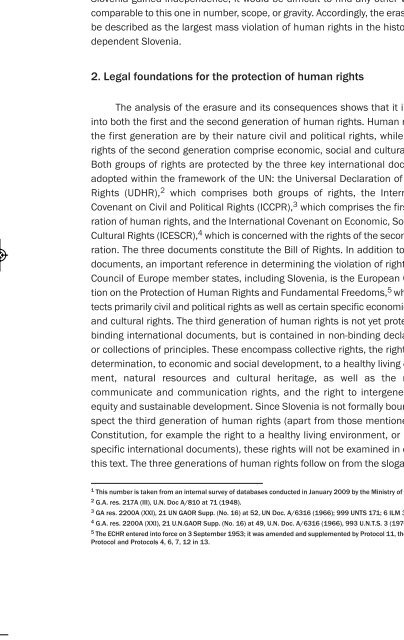The Scars of the Erasure_web
The Scars of the Erasure_web
The Scars of the Erasure_web
- No tags were found...
Create successful ePaper yourself
Turn your PDF publications into a flip-book with our unique Google optimized e-Paper software.
<strong>Erasure</strong>_4a 10.1.11 20:29 Page 8484 THE SCARS OF THE ERASURErights were violated. Moreover, <strong>the</strong> sheer number <strong>of</strong> people (25,671) 1 who sufferedas a consequence <strong>of</strong> <strong>the</strong> violation <strong>of</strong> <strong>the</strong>ir rights calls for recognition that<strong>the</strong> erasure was not simply a violation <strong>of</strong> human rights but a mass violation <strong>of</strong>human rights. A look into <strong>the</strong> past shows that since 1991, <strong>the</strong> year in whichSlovenia gained independence, it would be difficult to find any o<strong>the</strong>r violationcomparable to this one in number, scope, or gravity. Accordingly, <strong>the</strong> erasure canbe described as <strong>the</strong> largest mass violation <strong>of</strong> human rights in <strong>the</strong> history <strong>of</strong> independentSlovenia.2. Legal foundations for <strong>the</strong> protection <strong>of</strong> human rights<strong>The</strong> analysis <strong>of</strong> <strong>the</strong> erasure and its consequences shows that it intrudedinto both <strong>the</strong> first and <strong>the</strong> second generation <strong>of</strong> human rights. Human rights <strong>of</strong><strong>the</strong> first generation are by <strong>the</strong>ir nature civil and political rights, while humanrights <strong>of</strong> <strong>the</strong> second generation comprise economic, social and cultural rights.Both groups <strong>of</strong> rights are protected by <strong>the</strong> three key international documentsadopted within <strong>the</strong> framework <strong>of</strong> <strong>the</strong> UN: <strong>the</strong> Universal Declaration <strong>of</strong> HumanRights (UDHR), 2 which comprises both groups <strong>of</strong> rights, <strong>the</strong> InternationalCovenant on Civil and Political Rights (ICCPR), 3 which comprises <strong>the</strong> first gene -ration <strong>of</strong> human rights, and <strong>the</strong> International Covenant on Economic, Social andCultural Rights (ICESCR), 4 which is concerned with <strong>the</strong> rights <strong>of</strong> <strong>the</strong> second gene -ration. <strong>The</strong> three documents constitute <strong>the</strong> Bill <strong>of</strong> Rights. In addition to <strong>the</strong> UNdocuments, an important reference in determining <strong>the</strong> violation <strong>of</strong> rights in <strong>the</strong>Council <strong>of</strong> Europe member states, including Slovenia, is <strong>the</strong> European Conventionon <strong>the</strong> Protection <strong>of</strong> Human Rights and Fundamental Freedoms, 5 which protectsprimarily civil and political rights as well as certain specific economic, socialand cultural rights. <strong>The</strong> third generation <strong>of</strong> human rights is not yet protected bybinding international documents, but is contained in non-binding declarationsor collections <strong>of</strong> principles. <strong>The</strong>se encompass collective rights, <strong>the</strong> right to selfdetermination,to economic and social development, to a healthy living environment,natural resources and cultural heritage, as well as <strong>the</strong> right tocommunicate and communication rights, and <strong>the</strong> right to intergenerationalequity and sustainable development. Since Slovenia is not formally bound to respect<strong>the</strong> third generation <strong>of</strong> human rights (apart from those mentioned in itsConstitution, for example <strong>the</strong> right to a healthy living environment, or in o<strong>the</strong>rspecific international documents), <strong>the</strong>se rights will not be examined in detail inthis text. <strong>The</strong> three generations <strong>of</strong> human rights follow on from <strong>the</strong> slogan <strong>of</strong> <strong>the</strong>1 This number is taken from an internal survey <strong>of</strong> databases conducted in January 2009 by <strong>the</strong> Ministry <strong>of</strong> <strong>the</strong> Interior.2 G.A. res. 217A (III), U.N. Doc A/810 at 71 (1948).3 GA res. 2200A (XXI), 21 UN GAOR Supp. (No. 16) at 52, UN Doc. A/6316 (1966); 999 UNTS 171; 6 ILM 368 (1967).4 G.A. res. 2200A (XXI), 21 U.N.GAOR Supp. (No. 16) at 49, U.N. Doc. A/6316 (1966), 993 U.N.T.S. 3 (1976).5 <strong>The</strong> ECHR entered into force on 3 September 1953; it was amended and supplemented by Protocol 11, <strong>the</strong> additionalProtocol and Protocols 4, 6, 7, 12 in 13.


